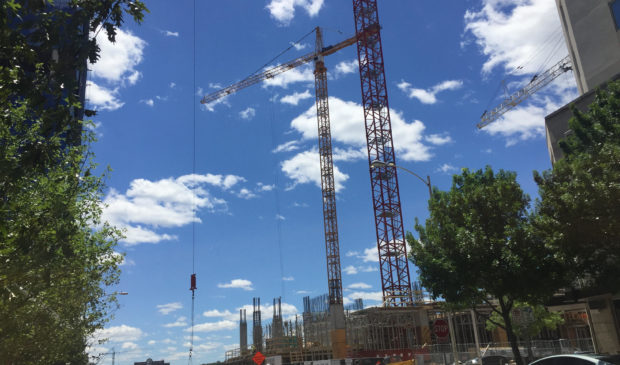The many balancing acts in Austin’s quest for affordable housing
Tuesday, July 25, 2017 by
Jack Craver When it comes to providing housing that is affordable to Austin’s poor and working-class residents, city leaders have very few tools at their disposal.
The city is barred by state law from implementing the types of regulations that other major cities have used to create cheaper housing, notably rent control and inclusionary zoning. This spring the city lost access to yet another potential tool when the Texas Legislature passed a law prohibiting linkage fees, a tax that some cities impose on new developments to fund affordable housing programs.
As a result, affordability advocates in Austin are placing much of their hope in density bonuses, a system in which developers are allowed to build bigger buildings than they would normally be permitted under the code as long as they reserve a certain percentage of the new units for people at a certain income level.
Austin already has a number of density bonus programs in place targeting certain neighborhoods, but the first draft of CodeNEXT, the overhaul of the city’s land development code, proposes a dramatic expansion in the hopes that it will lead to affordable housing throughout the city.
If approved, 19,100 acres of the city would be eligible for density bonuses, compared to only 6,200 currently.
The type of bonus would differ based on the zoning. For instance, in the T-5 zone, which is designated for relatively high density, builders would be able to construct seven stories instead of six. In another zone, a builder may be able to build eight units instead of four.
In addition to the likely opposition that increased density will face in certain neighborhoods, the proposed program will also face doubts about its design, notably whether it is helping those who have the greatest need and whether the affordable housing is being distributed equitably throughout the city.
The many tough choices the authors of the new code face were put on display at a recent meeting of the Planning Commission, as city staff described to commissioners the risks and rewards of different approaches.
For instance, while the proposed program aims to provide rental units that are affordable for those at 60 percent of the median family income, or MFI, and owner-occupied units for those at 80 percent MFI, Erica Leak of the Neighborhood Housing and Community Development Department said the city could try to target those with incomes as low as 30 percent MFI. But the problem is that the steeper the discount on income-restricted units, the fewer the developer will be willing or able to provide.
A similar balancing act comes into play when trying to create affordable housing for families with children. A number of commissioners expressed concerns that, just as much of the new market-rate construction consists of studios or one-bedroom apartments geared toward singles or childless couples, very little of the income-restricted housing would accommodate larger households.
“Our challenge is family housing and we’re trying to put families in new, little apartments,” said Commissioner Karen McGraw.
The city could encourage developers to build larger affordable units, said Leak, but that too would likely mean accepting fewer units overall.
Finally, while staff repeatedly emphasized that the goal of the program was to get developers to build the affordable units at the same site as the market-rate units, thereby encouraging income diversity, they also acknowledged there might be instances in which the city will allow builders to construct the affordable units elsewhere or not build units at all, instead paying a fee-in-lieu to the city’s affordable housing trust fund.
It’s still not clear how the city would determine who is exempt from the on-site requirement, but Leak said the plan is for there to be a board composed of industry experts who will decide whether there is a reason that on-site units aren’t economically feasible.
McGraw noted that it would likely be more expensive and challenging for the city to monitor and enforce the income restrictions at smaller developments. For instance, an eight-unit building that includes only one affordable unit.
“If we’re going to have one or two units in a building, there will be higher administrative costs,” said Leak, adding that in some instances the city might be better off taking a fee-in-lieu and then partnering with a nonprofit to build affordable units elsewhere. But the problem with that approach, she explained, is that it would likely be harder for the city to find places in “high-opportunity areas” with access to public transit and other amenities to put those units.
As is the case with the rest of CodeNEXT, which is currently undergoing a major revision, nothing is final about the proposed new density bonus program. By the time the new code is adopted, it could be substantially pared back or much more aggressive.
Curious about how we got here? Check out the Austin Monitor’s CodeNEXT Timeline.
The Austin Monitor’s work is made possible by donations from the community. Though our reporting covers donors from time to time, we are careful to keep business and editorial efforts separate while maintaining transparency. A complete list of donors is available here, and our code of ethics is explained here.
You're a community leader
And we’re honored you look to us for serious, in-depth news. You know a strong community needs local and dedicated watchdog reporting. We’re here for you and that won’t change. Now will you take the powerful next step and support our nonprofit news organization?




